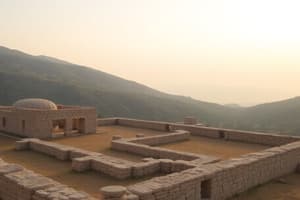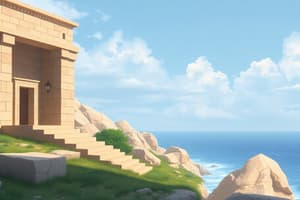Podcast
Questions and Answers
What is the significance of the year 776 BCE in ancient Greek history?
What is the significance of the year 776 BCE in ancient Greek history?
The first Olympic Games took place.
Which art style was characterized by linear designs and patterns like triangles and zigzags?
Which art style was characterized by linear designs and patterns like triangles and zigzags?
- Encaustic painting
- Geometric style (correct)
- Black-figure pottery
- Proto-geometric style
Ancient Greek artists primarily created their sculptures in a single color.
Ancient Greek artists primarily created their sculptures in a single color.
False (B)
What was a major contribution of Greek Classicism to fine art?
What was a major contribution of Greek Classicism to fine art?
The ________ painting technique became popular during the sixth century for stone statues.
The ________ painting technique became popular during the sixth century for stone statues.
What was the highest form of painting according to authors like Pliny and Pausanias?
What was the highest form of painting according to authors like Pliny and Pausanias?
What type of subject matter became popular in Hellenistic Greek painting?
What type of subject matter became popular in Hellenistic Greek painting?
The Greeks had a complex religion emerge during the 8th century BCE.
The Greeks had a complex religion emerge during the 8th century BCE.
What aspect of stone sculptures was usually painted?
What aspect of stone sculptures was usually painted?
What new subjects became prominent in Hellenistic Greek painting?
What new subjects became prominent in Hellenistic Greek painting?
How was sculpture-painting perceived in the context of art?
How was sculpture-painting perceived in the context of art?
What kind of materials besides paint were sometimes used to adorn sculptures?
What kind of materials besides paint were sometimes used to adorn sculptures?
Which aspect of painting was a significant contribution of Hellenistic painters?
Which aspect of painting was a significant contribution of Hellenistic painters?
What civilization is identified with the origins of Aegean Art during the Third Millennium BCE?
What civilization is identified with the origins of Aegean Art during the Third Millennium BCE?
Which significant event took place around 776 BCE that marked a cultural milestone in ancient Greece?
Which significant event took place around 776 BCE that marked a cultural milestone in ancient Greece?
During which period did Greek pottery develop from linear designs to more complex geometric patterns?
During which period did Greek pottery develop from linear designs to more complex geometric patterns?
What was a distinguishing feature of black-figure pottery developed in Corinth?
What was a distinguishing feature of black-figure pottery developed in Corinth?
What did the growth of pottery and sculpture in the 7th century lead to in the realm of art?
What did the growth of pottery and sculpture in the 7th century lead to in the realm of art?
Which culture significantly influenced the art style of the Minoans?
Which culture significantly influenced the art style of the Minoans?
What characterizes the Archaic Greek pottery's most developed form during the pre-Archaic period?
What characterizes the Archaic Greek pottery's most developed form during the pre-Archaic period?
What technological advancement coincided with the emergence of ancient Greek art in the 8th century BCE?
What technological advancement coincided with the emergence of ancient Greek art in the 8th century BCE?
What technique was used in sculptures during the Classical period for adding color?
What technique was used in sculptures during the Classical period for adding color?
Which painting method was noted for being less esteemed than panel painting?
Which painting method was noted for being less esteemed than panel painting?
What aspect of the Classical Greek painting contributed to its higher reputation during the period?
What aspect of the Classical Greek painting contributed to its higher reputation during the period?
Which of the following was a hallmark of Greek Classicism's contribution to sculpture?
Which of the following was a hallmark of Greek Classicism's contribution to sculpture?
What decorative technique was commonly used on the walls of temples and public buildings?
What decorative technique was commonly used on the walls of temples and public buildings?
The depiction of women in a procession from Hagia Triada suggests what possible emotion?
The depiction of women in a procession from Hagia Triada suggests what possible emotion?
What was a characteristic of panel painting during the Classical Greek period?
What was a characteristic of panel painting during the Classical Greek period?
What technique did Greek artists master for adding color to different materials aside from painting?
What technique did Greek artists master for adding color to different materials aside from painting?
Flashcards are hidden until you start studying
Study Notes
Origins
- Aegean Art dates to the Minoan culture around 2100 BCE in Crete, showcasing a thriving maritime trading society.
- Minoans built palaces at Knossos, Phaestus, and Akrotiri, influenced by Sumerian and Mesopotamian art.
- Key artistic outputs include fresco paintings, stone carvings, and ancient pottery.
Historical Background
- Ancient Greek art emerged in the 8th century BCE, around the time of socio-political stabilization in the Aegean.
- Significant developments included the introduction of iron tools and weapons, the Greek alphabet, and the first Olympic Games in 776 BCE.
- A complex religious system and cultural identity centered around "Hellas" developed during this period.
Archaic Greek Pottery
- The primary art form of the pre-Archaic period (c. 900-650 BCE) was pottery, noted for decorative large vases.
- Initial pottery styles included proto-geometric (linear designs) and geometric styles (triangles, zigzags).
- Introduced by Corinth, black-figure pottery featured figures in black silhouette with incised details.
Archaic Greek Painting
- The evolution of pottery and sculpture in the 7th century spurred an increase in Greek painting.
- Temples and buildings incorporated fresco painting; sculptures were often adorned with tempered or encaustic paints.
- Encaustic painting provided a lustrous finish similar to oil, which was unfamiliar to the Greeks.
Classical Period (c. 480-323 BCE)
- Sculpture was the hallmark of Greek Classicism, exemplified by the "Canon of Proportions" defining the "ideal human body."
- Classical Greek painting mastered linear perspective and natural representation, unmatched until later Renaissance.
- Panel painting, done in encaustic or tempera, was considered the highest form of painting by ancient authors.
- Fresco painting was common for mural decoration but seen as inferior to panel paintings.
Hellenistic Painting
- The rise in demand for Greek-style sculpture paralleled the popularity of Hellenistic painting across different schools.
- The subject matter evolved from classical themes of mythology to include genre scenes, animals, still lifes, and landscapes.
- A key contribution of Hellenistic artists was in portrait art, showcasing individuality and realism in subjects.
Origins
- Aegean Art dates to the Minoan culture around 2100 BCE in Crete, showcasing a thriving maritime trading society.
- Minoans built palaces at Knossos, Phaestus, and Akrotiri, influenced by Sumerian and Mesopotamian art.
- Key artistic outputs include fresco paintings, stone carvings, and ancient pottery.
Historical Background
- Ancient Greek art emerged in the 8th century BCE, around the time of socio-political stabilization in the Aegean.
- Significant developments included the introduction of iron tools and weapons, the Greek alphabet, and the first Olympic Games in 776 BCE.
- A complex religious system and cultural identity centered around "Hellas" developed during this period.
Archaic Greek Pottery
- The primary art form of the pre-Archaic period (c. 900-650 BCE) was pottery, noted for decorative large vases.
- Initial pottery styles included proto-geometric (linear designs) and geometric styles (triangles, zigzags).
- Introduced by Corinth, black-figure pottery featured figures in black silhouette with incised details.
Archaic Greek Painting
- The evolution of pottery and sculpture in the 7th century spurred an increase in Greek painting.
- Temples and buildings incorporated fresco painting; sculptures were often adorned with tempered or encaustic paints.
- Encaustic painting provided a lustrous finish similar to oil, which was unfamiliar to the Greeks.
Classical Period (c. 480-323 BCE)
- Sculpture was the hallmark of Greek Classicism, exemplified by the "Canon of Proportions" defining the "ideal human body."
- Classical Greek painting mastered linear perspective and natural representation, unmatched until later Renaissance.
- Panel painting, done in encaustic or tempera, was considered the highest form of painting by ancient authors.
- Fresco painting was common for mural decoration but seen as inferior to panel paintings.
Hellenistic Painting
- The rise in demand for Greek-style sculpture paralleled the popularity of Hellenistic painting across different schools.
- The subject matter evolved from classical themes of mythology to include genre scenes, animals, still lifes, and landscapes.
- A key contribution of Hellenistic artists was in portrait art, showcasing individuality and realism in subjects.
Studying That Suits You
Use AI to generate personalized quizzes and flashcards to suit your learning preferences.



